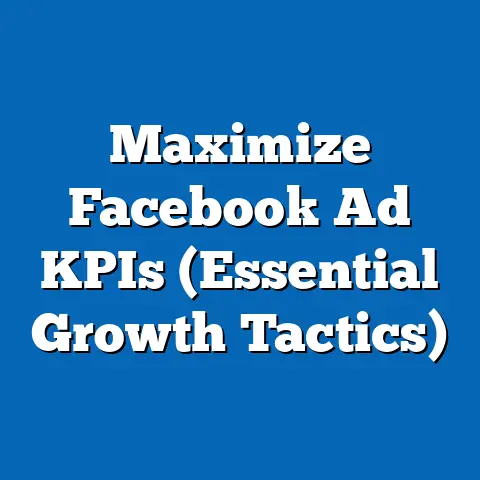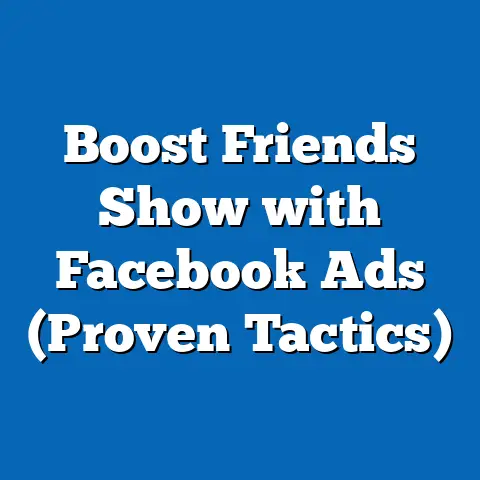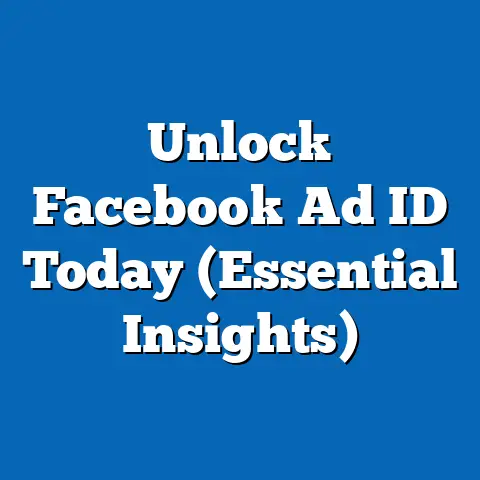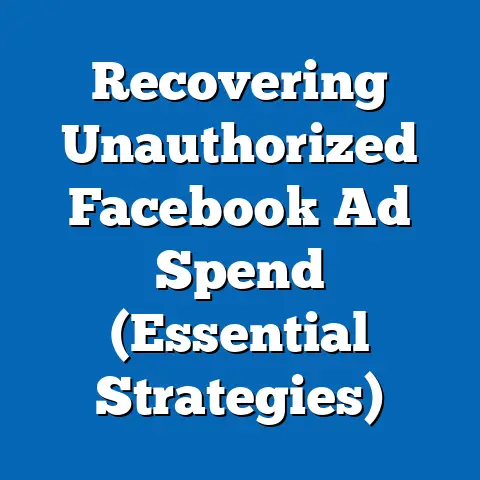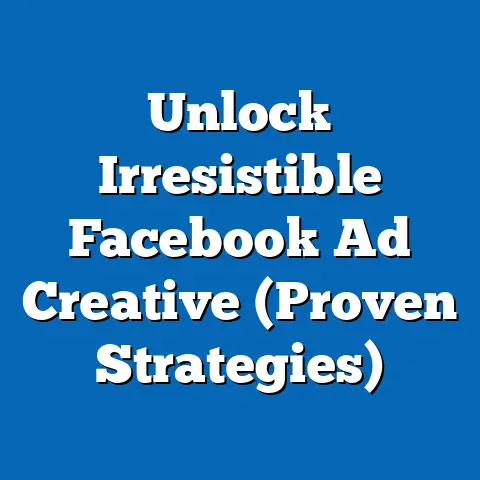Unlock Agency Training Success (Proven Facebook Ads Strategies)
In today’s digital marketing arena, where algorithms shift faster than the sands of the Sahara, marketing agencies are grappling with a significant challenge: how to effectively train their teams to master Facebook Ads. I’ve seen firsthand how agencies struggle to stay ahead, investing time and resources only to find their teams not quite hitting the mark. It’s a problem I’ve tackled head-on, and this guide is the culmination of those experiences.
With constant updates, evolving audience behaviors, and a flood of new tools, keeping training programs relevant and impactful is no easy feat. Many agencies find themselves in a frustrating cycle of trial and error, which leads to wasted budgets and missed client opportunities. The real challenge lies not just in understanding the mechanics of Facebook Ads but in implementing proven strategies that consistently drive success.
This guide isn’t just another collection of tips; it’s a roadmap I’ve developed and refined over years of working with agencies. I’ll walk you through identifying common training pitfalls, crafting an effective curriculum, integrating the latest tools, and measuring success with key performance indicators (KPIs). My goal is to provide you with actionable strategies that you can immediately implement to transform your agency’s Facebook Ads performance.
1. Understanding the Importance of Facebook Ads in the Marketing Mix
Facebook Ads are no longer just an option; they’re a necessity for businesses seeking to thrive in the digital age. When I first started in digital marketing, social media was more of a “nice-to-have” than a core strategy. Today, it’s the linchpin of many successful campaigns.
The Role of Facebook Ads in Digital Marketing
Facebook Ads play a pivotal role in the modern marketing mix, acting as a powerful tool for:
- Brand Awareness: Increasing visibility and recognition among target audiences.
- Lead Generation: Capturing valuable leads through targeted campaigns and compelling offers.
- Website Traffic: Driving qualified traffic to your website to increase conversions.
- Sales and Revenue: Directly boosting sales by promoting products or services to interested buyers.
- Audience Engagement: Fostering meaningful interactions with your audience, building loyalty, and driving advocacy.
Facebook’s extensive reach and sophisticated targeting capabilities make it an indispensable platform for agencies looking to deliver results for their clients.
Current Trends and Statistics
Let’s dive into some eye-opening statistics that highlight the importance of Facebook advertising:
- User Base: Facebook boasts nearly 3 billion monthly active users, providing an unparalleled audience reach.
- Advertising Revenue: In 2023, Meta (Facebook’s parent company) generated over \$116 billion in advertising revenue, underscoring the platform’s immense value to advertisers.
- Mobile Advertising: Mobile ads account for approximately 94% of Facebook’s advertising revenue, reflecting the dominance of mobile usage.
- Return on Ad Spend (ROAS): Studies show that businesses can achieve an average ROAS of \$4.37 for every dollar spent on Facebook Ads, making it a highly cost-effective channel.
These figures aren’t just numbers; they represent real opportunities for agencies to tap into a vast and engaged audience, driving tangible results for their clients. I’ve seen firsthand how a well-crafted Facebook Ads campaign can transform a struggling business into a thriving one.
The Facebook Ads Ecosystem
The Facebook Ads ecosystem is a complex but powerful network that includes:
- Facebook: The core platform with its extensive user base and diverse ad formats.
- Instagram: A visually driven platform that is ideal for engaging younger audiences.
- Audience Network: A network of third-party apps and websites where Facebook Ads can be displayed.
- Messenger: A messaging app with advertising opportunities for direct engagement with customers.
Understanding how these components work together is crucial for agencies. Each platform offers unique advantages and targeting options, allowing you to tailor your campaigns to specific audiences and objectives. For example, Instagram is perfect for showcasing visually appealing products, while Messenger can be used for personalized customer service and direct promotions.
Takeaway: Facebook Ads are a critical component of any modern marketing strategy. Agencies that master this platform can deliver significant value to their clients and stay ahead in the competitive digital landscape. The key is to understand the ecosystem, stay updated on trends, and continuously optimize your campaigns for maximum impact.
2. Identifying Common Pitfalls in Agency Training Programs
I’ve seen countless agencies make the same mistakes when it comes to Facebook Ads training. It’s not always a lack of effort; often, it’s a lack of understanding of what makes training truly effective in this dynamic field.
Why Traditional Training Methods Often Fail
Traditional training methods, such as static webinars or outdated manuals, often fall short because they:
- Lack Practical Application: Focusing too much on theory without providing hands-on experience.
- Are Outdated: Failing to keep up with the constant changes to Facebook’s algorithms and features.
- Are Not Tailored: Offering a one-size-fits-all approach that doesn’t cater to different skill levels.
- Lack Engagement: Failing to engage trainees and make the learning process interactive and enjoyable.
When I first started training teams, I relied heavily on comprehensive manuals. However, I quickly realized that reading about Facebook Ads is vastly different from actually creating and managing successful campaigns. The disconnect between theory and practice was a major obstacle.
The Gap Between Theoretical Knowledge and Practical Application
The gap between theoretical knowledge and practical application is a significant challenge in Facebook Ads training. Trainees may understand the concepts but struggle to apply them in real-world scenarios. This can lead to:
- Hesitation: Reluctance to experiment and take risks.
- Analysis Paralysis: Overthinking decisions and failing to take action.
- Ineffective Campaigns: Creating ads that don’t resonate with the target audience or achieve the desired results.
To bridge this gap, I started incorporating more hands-on exercises and real-world case studies into my training sessions. This allowed trainees to apply their knowledge in a safe and controlled environment, building confidence and competence.
Consequences of Inadequate Training
Inadequate training can have severe consequences for agencies, including:
- Poor Campaign Performance: Underperforming ads that fail to meet client objectives.
- Wasted Budgets: Inefficient ad spending that doesn’t generate a positive return on investment.
- Client Dissatisfaction: Unhappy clients who may choose to take their business elsewhere.
- Reputational Damage: Negative reviews and word-of-mouth that can harm the agency’s reputation.
- Missed Opportunities: Failing to capitalize on emerging trends and new features.
I once worked with an agency that lost a major client due to consistently underperforming Facebook Ads campaigns. The root cause? Inadequate training that left the team ill-equipped to handle the complexities of the platform. This experience underscored the importance of investing in comprehensive and ongoing training.
Takeaway: Identifying and addressing these common pitfalls is crucial for creating a successful Facebook Ads training program. Agencies must move beyond traditional methods, bridge the gap between theory and practice, and recognize the serious consequences of inadequate training. The next step is to craft a curriculum that meets the specific needs of your team and clients.
3. Crafting an Effective Facebook Ads Training Curriculum
Creating an effective Facebook Ads training curriculum requires careful planning and a deep understanding of the platform and its nuances. It’s not just about covering the basics; it’s about providing a holistic education that equips your team with the skills and knowledge to excel.
Essential Components of a Comprehensive Curriculum
A comprehensive Facebook Ads training program should include the following essential components:
- Foundational Knowledge: A thorough introduction to Facebook Ads, including its history, key concepts, and terminology.
- Account Setup and Management: Step-by-step guidance on setting up and managing Facebook Ads accounts, including business manager setup, pixel installation, and data privacy compliance.
- Audience Targeting: In-depth exploration of Facebook’s targeting options, including demographic, interest-based, behavioral, and custom audiences.
- Ad Creation and Optimization: Hands-on training on creating compelling ad copy and visuals, selecting the right ad formats, and optimizing campaigns for specific objectives.
- Bidding and Budgeting: Understanding different bidding strategies, setting realistic budgets, and optimizing ad spend for maximum ROI.
- Analytics and Reporting: Learning how to track key performance indicators (KPIs), analyze campaign performance, and generate actionable insights.
- Advanced Strategies: Exploring advanced techniques such as retargeting, lookalike audiences, and dynamic product ads.
- Compliance and Best Practices: Staying up-to-date on Facebook’s advertising policies, data privacy regulations, and industry best practices.
When I designed my first training program, I made sure to cover each of these components in detail. However, I quickly realized that the key was not just to cover the material but to make it engaging and relevant.
Tailoring Training to Different Skill Levels
Not everyone on your team will have the same level of experience with Facebook Ads. Therefore, it’s essential to tailor your training program to different skill levels. Consider offering:
- Beginner Courses: For those who are new to Facebook Ads, covering the basics and foundational concepts.
- Intermediate Workshops: For those with some experience, focusing on more advanced strategies and techniques.
- Advanced Seminars: For experienced professionals, exploring cutting-edge trends and best practices.
I’ve found that segmenting trainees based on their skill level allows for a more personalized and effective learning experience. It also ensures that everyone is challenged and engaged, regardless of their prior knowledge.
The Importance of Hands-On Training
Hands-on training is crucial for reinforcing theoretical knowledge and building practical skills. Incorporate the following elements into your training program:
- Live Demonstrations: Showing trainees how to perform specific tasks in real-time.
- Workshops and Exercises: Providing opportunities for trainees to practice what they’ve learned in a safe and controlled environment.
- Case Studies: Analyzing real-world examples of successful and unsuccessful campaigns.
- Simulations: Creating simulated scenarios that mimic real-world challenges.
When I conduct training sessions, I always allocate ample time for hands-on exercises. I’ve found that this is where the real learning happens, as trainees grapple with real-world challenges and apply their knowledge to solve problems.
Takeaway: Crafting an effective Facebook Ads training curriculum requires a comprehensive approach that covers foundational knowledge, advanced strategies, and hands-on training. By tailoring your program to different skill levels and incorporating real-world examples, you can equip your team with the skills and knowledge they need to excel.
4. Proven Facebook Ads Strategies for Agency Success
Now, let’s dive into the core of what drives success: the proven strategies that agencies can teach their teams to implement effectively. These aren’t just theoretical concepts; they’re the battle-tested tactics I’ve seen work time and again.
Audience Targeting Best Practices
Effective audience targeting is the cornerstone of any successful Facebook Ads campaign. Here are some best practices to keep in mind:
- Define Your Ideal Customer: Start by creating detailed buyer personas that outline your ideal customer’s demographics, interests, behaviors, and pain points.
- Leverage Facebook’s Targeting Options: Utilize Facebook’s extensive targeting options to reach your ideal customer, including demographic, interest-based, behavioral, and custom audiences.
- Create Custom Audiences: Upload customer lists, website visitors, or app users to create custom audiences that can be targeted with tailored ads.
- Use Lookalike Audiences: Expand your reach by creating lookalike audiences that share similar characteristics with your existing customers.
- Test and Refine: Continuously test and refine your targeting options to identify the most effective audiences.
When I work with agencies, I always emphasize the importance of starting with a clear understanding of their ideal customer. This helps them to focus their targeting efforts and create ads that resonate with the right people.
Crafting Compelling Ad Copy and Visuals
Compelling ad copy and visuals are essential for capturing attention and driving engagement. Here are some tips for crafting effective ads:
- Write Clear and Concise Copy: Use clear and concise language that communicates your message quickly and effectively.
- Highlight Benefits, Not Features: Focus on the benefits of your product or service, rather than just listing its features.
- Use Strong Calls to Action: Include clear and compelling calls to action that tell people what you want them to do.
- Use High-Quality Visuals: Use high-quality images and videos that are visually appealing and relevant to your message.
- Test Different Ad Variations: Continuously test different ad copy and visuals to identify the most effective combinations.
I’ve seen firsthand how a well-crafted ad can outperform a poorly written one, even with the same targeting options. The key is to focus on creating ads that are relevant, engaging, and visually appealing.
Utilizing Facebook’s Various Ad Formats Effectively
Facebook offers a variety of ad formats, each with its own unique advantages. Here are some tips for utilizing them effectively:
- Image Ads: Simple and versatile, ideal for showcasing products or services with a single image.
- Video Ads: Engaging and attention-grabbing, perfect for telling stories and demonstrating product features.
- Carousel Ads: Showcase multiple products or services in a single ad, allowing users to swipe through different images or videos.
- Collection Ads: Create a visually immersive experience that allows users to browse and purchase products directly from the ad.
- Lead Ads: Capture leads directly from Facebook without requiring users to leave the platform.
When choosing an ad format, consider your objectives, target audience, and the type of content you want to share. For example, if you’re promoting a product with multiple features, a carousel ad might be the best choice.
Implementing A/B Testing and Data Analysis
A/B testing and data analysis are crucial for optimizing your Facebook Ads campaigns. Here are some tips for implementing them effectively:
- Test One Variable at a Time: When A/B testing, test only one variable at a time to accurately measure its impact.
- Track Key Performance Indicators (KPIs): Monitor KPIs such as click-through rate (CTR), conversion rate, and cost per acquisition (CPA) to assess campaign performance.
- Use Facebook Analytics: Leverage Facebook Analytics to gain insights into user behavior and campaign effectiveness.
- Make Data-Driven Decisions: Use data to inform your decisions and continuously optimize your campaigns for maximum ROI.
I always emphasize the importance of data-driven decision-making. By continuously testing and analyzing your campaigns, you can identify what works and what doesn’t, and make adjustments accordingly.
Case Studies: Agencies Implementing Successful Strategies
To illustrate these strategies in action, let’s look at some real-world case studies:
- Agency A: Increased lead generation by 30% by implementing targeted custom audiences and compelling lead ads.
- Agency B: Improved ROAS by 40% by optimizing ad copy and visuals and implementing A/B testing.
- Agency C: Increased website traffic by 50% by utilizing carousel ads to showcase multiple products and services.
These case studies demonstrate the power of implementing proven Facebook Ads strategies. By following these best practices, agencies can achieve significant results for their clients.
Takeaway: Proven Facebook Ads strategies are essential for agency success. By focusing on effective audience targeting, compelling ad copy and visuals, utilizing various ad formats, and implementing A/B testing and data analysis, agencies can drive significant results for their clients.
5. Integrating Tools and Technology in Training
In the ever-evolving world of Facebook Ads, tools and technology are indispensable allies. Integrating them into your training program can significantly enhance your team’s capabilities and drive better results.
Tools That Enhance Facebook Ads Training
Here are some essential tools that can enhance Facebook Ads training:
- Facebook Ads Manager: The core tool for creating, managing, and optimizing Facebook Ads campaigns.
- Facebook Business Manager: A platform for managing multiple Facebook Ads accounts and business assets.
- Facebook Pixel: A code snippet that tracks website visitors and conversions, allowing you to create retargeting audiences and measure campaign effectiveness.
- Google Analytics: A web analytics service that provides insights into user behavior and website traffic.
- Canva: A graphic design tool for creating visually appealing ad creatives.
- AdEspresso: A Facebook Ads management platform that offers advanced features such as A/B testing and automation.
When I conduct training sessions, I always make sure to demonstrate how to use these tools effectively. I’ve found that hands-on experience with these tools is essential for building competence and confidence.
The Importance of Analytics and Reporting Tools
Analytics and reporting tools are crucial for understanding campaign performance and making data-driven decisions. Here are some key features to look for:
- Real-Time Data: Access to real-time data that allows you to monitor campaign performance and make adjustments on the fly.
- Customizable Reports: The ability to create customizable reports that track key performance indicators (KPIs).
- Data Visualization: Visual representations of data that make it easier to understand trends and patterns.
- Segmentation: The ability to segment data by demographics, interests, and behaviors.
I always emphasize the importance of tracking KPIs such as click-through rate (CTR), conversion rate, and cost per acquisition (CPA). These metrics provide valuable insights into campaign performance and help you to identify areas for improvement.
Automation Tools for Streamlining Ad Creation and Management
Automation tools can streamline the ad creation and management process, saving time and improving efficiency. Here are some examples:
- Automated Rules: Set up automated rules that automatically pause or adjust campaigns based on specific criteria.
- Dynamic Creative Optimization: Use dynamic creative optimization to automatically test different ad creatives and identify the most effective combinations.
- Automated Bidding: Utilize automated bidding strategies that optimize bids based on campaign objectives.
I’ve found that automation tools can be particularly helpful for managing large-scale campaigns. By automating repetitive tasks, you can free up your team to focus on more strategic initiatives.
Takeaway: Integrating tools and technology into your Facebook Ads training program can significantly enhance your team’s capabilities and drive better results. By providing hands-on experience with essential tools, emphasizing the importance of analytics and reporting, and utilizing automation tools, you can streamline the ad creation and management process and improve campaign performance.
6. Measuring Success: Key Performance Indicators (KPIs) for Facebook Ads
Measuring success is essential for understanding the effectiveness of your Facebook Ads campaigns and making data-driven decisions. Key Performance Indicators (KPIs) provide valuable insights into campaign performance and help you to identify areas for improvement.
Critical KPIs for Facebook Ads Campaigns
Here are some critical KPIs that agencies should focus on when evaluating the success of Facebook Ads campaigns:
- Reach: The number of unique people who saw your ad.
- Impressions: The number of times your ad was displayed.
- Click-Through Rate (CTR): The percentage of people who clicked on your ad after seeing it.
- Conversion Rate: The percentage of people who completed a desired action (e.g., making a purchase, filling out a form) after clicking on your ad.
- Cost Per Click (CPC): The average cost of each click on your ad.
- Cost Per Acquisition (CPA): The average cost of acquiring a new customer through your ad.
- Return on Ad Spend (ROAS): The amount of revenue generated for every dollar spent on advertising.
When I work with agencies, I always emphasize the importance of tracking these KPIs. They provide a clear picture of campaign performance and help you to identify areas for improvement.
Setting Realistic Goals and Benchmarks
Setting realistic goals and benchmarks is crucial for measuring success and tracking progress. Consider the following factors when setting goals:
- Industry Standards: Research industry standards to understand what is considered a good performance for your industry.
- Past Performance: Analyze past campaign performance to identify trends and set realistic goals based on historical data.
- Business Objectives: Align your goals with your overall business objectives.
I’ve found that setting SMART goals (Specific, Measurable, Achievable, Relevant, and Time-bound) is an effective way to ensure that your goals are realistic and aligned with your business objectives.
Using Data to Inform Future Training Sessions and Strategies
Data can be used to inform future training sessions and strategies. By analyzing campaign performance data, you can identify areas where your team needs additional training and develop strategies to improve performance. For example, if you notice that your team is struggling with ad copy, you can offer additional training on copywriting best practices.
Takeaway: Measuring success is essential for understanding the effectiveness of your Facebook Ads campaigns and making data-driven decisions. By focusing on critical KPIs, setting realistic goals and benchmarks, and using data to inform future training sessions and strategies, you can continuously improve your team’s performance and drive better results for your clients.
7. Building a Culture of Continuous Learning
The digital marketing landscape is in constant flux, especially when it comes to Facebook Ads. What works today might not work tomorrow. Therefore, building a culture of continuous learning is essential for agencies that want to stay ahead of the curve.
Importance of Fostering Ongoing Education
Fostering a culture of ongoing education ensures that your team stays up-to-date on the latest trends, best practices, and algorithm changes. This can lead to:
- Improved Campaign Performance: Staying up-to-date on the latest trends and best practices can help your team to create more effective campaigns.
- Increased Efficiency: Learning new tools and techniques can help your team to work more efficiently.
- Enhanced Innovation: Encouraging creativity and experimentation can lead to innovative new strategies.
I always emphasize the importance of continuous learning. It’s not enough to just complete a training program; you need to make learning a habit.
Methods for Staying Updated on Facebook Ads Trends
Here are some methods for staying updated on Facebook Ads trends and best practices:
- Follow Industry Blogs and Publications: Stay informed by following industry blogs and publications such as Social Media Examiner, AdEspresso, and Jon Loomer Digital.
- Attend Industry Conferences and Webinars: Attend industry conferences and webinars to learn from experts and network with peers.
- Join Online Communities: Join online communities such as Facebook groups and forums to share knowledge and learn from others.
- Experiment and Test: Continuously experiment and test new strategies to see what works.
I’ve found that a combination of these methods is the most effective way to stay up-to-date on the latest trends and best practices.
The Role of Mentorship and Peer-to-Peer Learning
Mentorship and peer-to-peer learning can play a significant role in enhancing team skills. By pairing experienced team members with newer ones, you can create a supportive learning environment where knowledge is shared and skills are developed.
Takeaway: Building a culture of continuous learning is essential for agencies that want to stay ahead of the curve. By fostering ongoing education, staying updated on Facebook Ads trends, and encouraging mentorship and peer-to-peer learning, you can create a team that is always learning, growing, and improving.
8. Conclusion: Embracing the Future of Facebook Advertising
As we reach the end of this guide, it’s important to remember that mastering Facebook Ads is not a destination but a journey. The platform is constantly evolving, and the strategies that work today might not work tomorrow.
Summarizing Key Points
Throughout this article, we’ve covered a range of topics, including:
- The importance of Facebook Ads in the marketing mix.
- Common pitfalls in agency training programs.
- Crafting an effective Facebook Ads training curriculum.
- Proven Facebook Ads strategies for agency success.
- Integrating tools and technology in training.
- Measuring success with key performance indicators (KPIs).
- Building a culture of continuous learning.
By implementing the strategies outlined in this guide, agencies can equip their teams with the skills and knowledge they need to excel in the world of Facebook Advertising.
Reinforcing the Ongoing Process
Successful agency training in Facebook Ads is not a one-time event but an ongoing process. It requires a commitment to continuous learning, adaptation, and experimentation.
Embracing Change and Adapting Strategies
To thrive in the competitive landscape of digital marketing, agencies must embrace change and adapt their training strategies to stay ahead of the curve. This means:
- Staying up-to-date on the latest trends and best practices.
- Experimenting with new strategies and techniques.
- Continuously measuring and analyzing campaign performance.
- Adapting your training program to meet the evolving needs of your team and clients.
The future of Facebook Advertising is bright, but it requires a willingness to learn, adapt, and innovate. By embracing these principles, agencies can unlock their full potential and drive significant results for their clients.
So, take the knowledge and strategies I’ve shared here and begin implementing them within your agency. Remember, the key to success isn’t just knowing the information, but actively applying it and continuously learning as the landscape evolves. I’m confident that with the right approach, your agency can achieve remarkable success with Facebook Ads.

